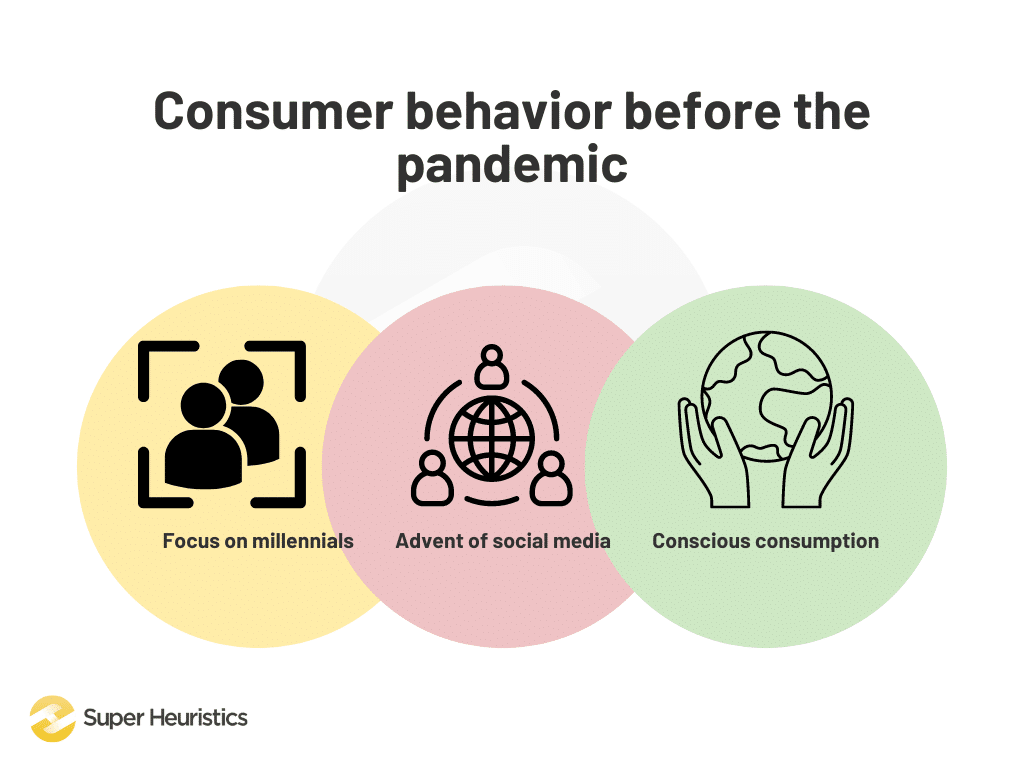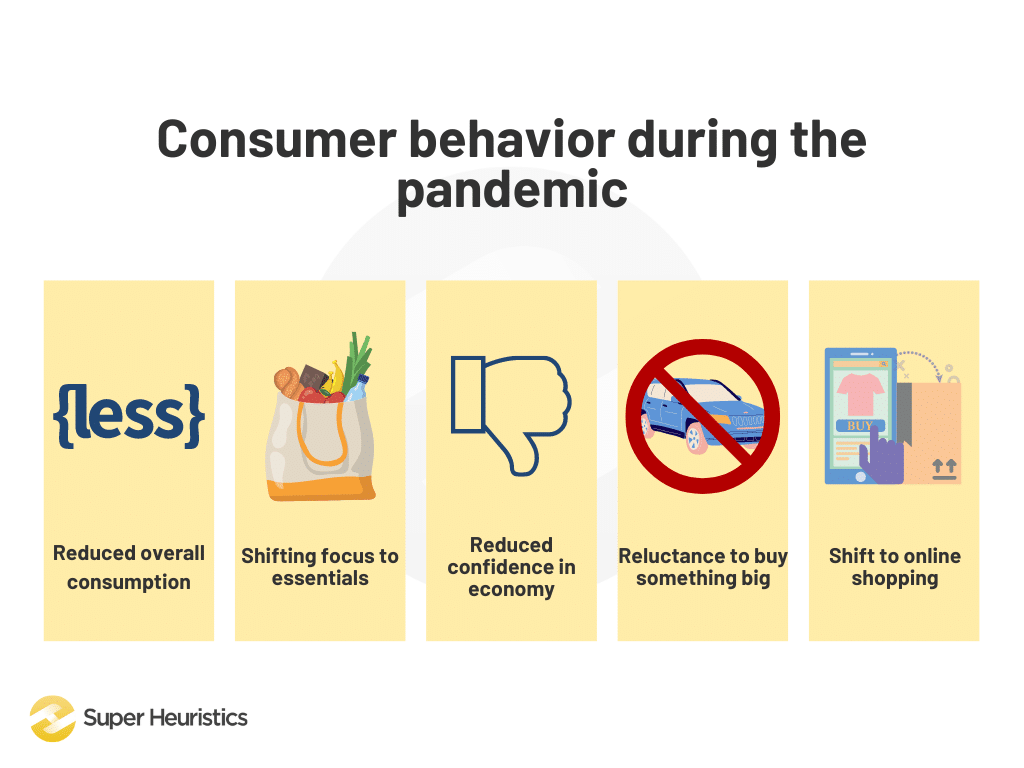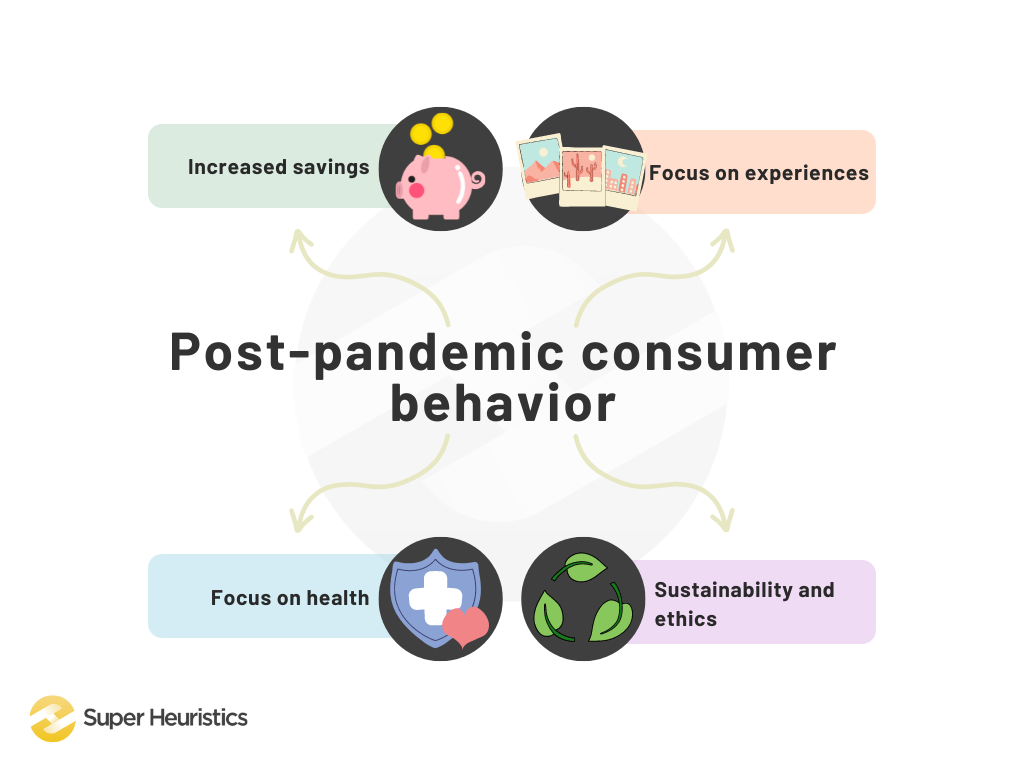The only constant thing in life is change itself. Staying true to this famous saying, there were changes in consumer behavior due to the pandemic globally and drastically. Be it the tourism sector or the pharmaceutical industry, each industry was hard hit by the pandemic in some way or the other.
But what is the relation between the pandemic and consumer behavior? More specifically, how did it affect how the average consumer spends and consumes?
To study the changes in consumer behavior due to pandemic, we will look at three phases - before, during, and after. We will take a look at these three phases in chronological order to understand the changes brought about by the pandemic in a clearer light.
Consumer behavior before the pandemic
To bring more clarity and focus to our study of changes in consumer behavior due to pandemic, let us narrow our geographical area to our homeland, India itself. Let us discuss the prevalent trends in consumer behavior in India in 2018 as per Economic Times.

1. Focusing on millennials
It should come as no surprise that India is home to a young population. In 2018 as well, a majority of India’s population consisted of millennials and gen z. India had the world’s largest millennial population in absolute terms. It homed 440 million millennials, who formed about 34% of the entire population.
Since India’s huge market consisted mostly of youngsters, brands shifted their focus to the millennial sector in 2018, because gen z was too young to earn and spend. In fact, more millennials used social media than gen z. So millennials were the trendsetters as well as the trend followers.
Marketers found it easier to earn from millennials than they did from older generations who were already rigid in their ways. It was easier to persuade millennials to try new products and services than it was to convince older generations to try something new, even if it was better than what they already used.
For example, if you were in the age group of 18-35 in 2018, you are a millennial. You could find a lot of marketing efforts from the brands of a product you liked (say, instant noodles). On the other hand, even you would have found it difficult to convince your parents to try something new.
2. The advent of social media
In today's connected consumer world, the significance of "S-commerce," or social commerce, has significantly increased. User-generated advertorial content includes images and videos of goods and brands that customers post on social media platforms and blogs, as well as user experiences and narratives shared online.
A particular product, brand, or service is either promoted or demonized by this content among a particular group of people—those who have access to view or read it. Some other forms of social commerce include:
Peer-to-peer sales platforms (community-based marketplaces)
Group buying (where products and services are offered at reduced rates if enough buyers are willing to make the purchase)
User-curated shopping (where users create and share lists of products/services for others to shop from)
Participatory commerce (where consumers become decision makers across the product value chain through voting, funding, collaboratively designing, etc.)
The millennial generation's shopping process is significantly influenced by social media platforms and online reviews of products and services. They became more information-driven consumers, but where the information should be from a reliable consumer.
3. Conscious consumption
Because hygiene is so important in determining the products consumers choose and the ways in which they consume food, consumers became more aware of the quality of ingredients.
Many brands shifted their focus to healthier food product options. This was a deliberate shift in the brands' values to provide healthier options to customers who were becoming more aware of their eating habits, the ingredients in the food they were consuming, and the nutritional value the food products offered.
This shift in consumption patterns was caused by factors including consumers' sedentary lifestyles, an increase in the number of workers, easier access to global trends, and higher disposable income levels. A rise in health-related incidents and consumers' increased interest in fitness and health led to a change in business priorities.
Millennials were said to be the ones driving this trend, but it was visible in all consumer categories, regardless of age group. As a result, businesses were pressured to make their products healthier or risk losing out on a significant consumer-driven trend.
These were some of the major consumer trends before the pandemic hit. We have successfully executed the first step in learning the changes in consumer behavior due to the pandemic.
In March 2020, the Government of India effectuated a nationwide lockdown to control the spread of the global COVID-19 pandemic in the country. Let us now look at the consumer trends during this period of lockdown.
Consumer behavior during the pandemic
The first case of COVID-19 in India was recorded on 27 January 2020 in Kerala. The exponential increase in cases following the first case forced the government to use several legislations and impose restrictions on the citizens of the country. These restrictions included wearing of face masks in public places, getting vaccinated, and even lockdowns.
Obviously, people started spending more on medical supplies such as masks, gloves, and sanitizers. Many were also quick to hoard personal hygiene products like toilet paper, sanitary pads, etc. But what were the major trends seen across all consumer groups?
This is the second step in learning the changes in consumer behavior due to the pandemic. We will now look at Indian consumer behavior during the pandemic.

According to an article on Mint, a study by Bain & Co. and People Research on India’s Consumer Economy (PRICE) in 2020 found that the COVID-19 pandemic changed Indian consumer behavior drastically. 50% of households reduced their overall consumption, of which 33% were driven by reduced income and 26% by future uncertainty.
Indian consumers shifted the focus of their consumption from discretionary goods like alcohol and consumer electronics to essentials like groceries and healthcare. The obvious reason for this shift was the lack of access due to the lockdown. Other reasons might include a reduction in disposable income, uncertainty, etc.
The confidence in the economy also dropped, and consumers started looking for cheaper alternatives to their staples in fear of an economic recession. 15% of households bought cheaper alternatives in essential categories, including staples, groceries, and household hygiene.
Because of the economic slowdown, many consumers were reluctant to buy something big and costly right away. Many put off their purchases for even 12 months. The worst-hit sectors were consumer durables and automobiles in this case.
Consumers shifted to online shopping as an alternative for the traditional physical shopping modes because of lack of access to markets and malls. Several big companies like ITC started partnering with online delivery apps like Swiggy, following the success of restaurants on the same.
The lockdowns ended as soon as they started, and people were quick to take advantage of their ‘newfound’ freedom. But how did the consumer behavior trends change again? Let’s take a look at them to have a better understanding of the changes in consumer behavior due to the pandemic.
Post-pandemic consumer behavior
The final step in understanding the changes in consumer behavior due to the pandemic is taking a look at consumer behavior after the pandemic. As should be clear by reading the first two parts of this Chapter, there was a huge shift in the mentality of consumers during the pandemic.
However, consumers were forced to rethink their preferences and buying patterns as soon as the pandemic ended. Let us see how. An EY report of a study conducted in 2022 found some interesting features of consumer behavior in India.

1. More savings
We all felt a sense of betrayal as our normal day-to-day life came to a standstill when the pandemic first hit. Personally, my number one reason for hating COVID-19 is that it ruined all my plans of making the last year of my school life my best one.
The entire pandemic can be summed up in one word - uncertainty. Prices rose as demand was soaring while supply was not. Health concerns were on the rise as well, because COVID-19 infections didn’t come as viral fever alone but brought along many life-long ailments like organ damage, steep falls in mental health, etc.
Over 80% of Indians are saving more money than they have in the past due to uncertainty about how to manage rising living expenses, and 50% of all respondents have already set a goal to save money rather than spend it.
2. Focus on experiences
We were deprived of sensory enjoyment during the pandemic. From resorts to spas, everything was out of reach. We craved butter chicken from the nearest restaurant but got dal roti instead.
The Indian market saw a huge increase in the number of consumers who prioritized experiences when deciding where to spend. Experience became the number one priority segment in India, with 31% of consumers prioritizing experience over other sectors.
3. Focus on health
Apart from experience, Indian consumers continued to spend a major portion of their income on healthcare. For the next two to three years, physical health and wellness have been set as a goal by 54% of respondents in India.
In the long run, physical health will be of greater concern to 80% of Indian respondents, followed by mental health at 78%. This supports the idea that, despite inflationary pressure, Indian consumers are willing to pay a premium for high-quality and organic food.
4. Sustainability and ethics
While only 37% of consumers worldwide place importance on sustainability when making purchases, 70% of consumers in India are conscious. This trend is more prevalent among millennials and Gen Xers.
The highest percentage of respondents in the world—more than 75%—say that they will consider a purchase's long-term effects on the environment and society. Indian consumers are also going back to traditional products as they are more natural and more easily biodegradable.
Conclusion and key takeaways
In this Chapter, we have studied the changes in consumer behavior due to the pandemic. From the three phases discussed above, it is clear that Indian consumers went through a lot of ups and downs through the last three years. To summarize, let us look at the key takeaways from this chapter:
- Consumer behavior before the pandemic included the following features - focus on millennials, the advent of social media, and conscious consumption.
- Consumer behavior during the pandemic displayed the following features - reduced overall consumption, shift in focus from discretionary goods to essentials, drop in the confidence in the economy, reluctance to buy something big and costly, and a huge shift towards online shopping.
- Consumer behavior after the pandemic showed the following features - more savings, focus on experience, focus on health, and focus on sustainability and ethics.
In the next and final chapter of this series, we shall take a look at the case study of a very popular food delivery app - Swiggy!

